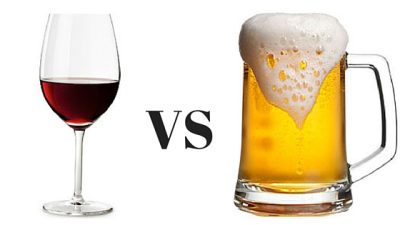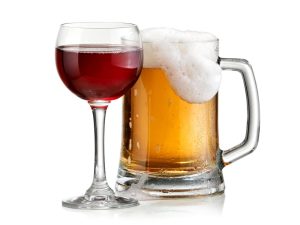When it comes to alcoholic beverages, wine, and beer are two of the most popular options around the world. Both are beloved for their unique flavors, aromas, and cultural significance. However, the debate of “wine vs beer” has been a longstanding one, with enthusiasts and connoisseurs on both sides advocating for their preferred beverage.
While both wine and beer have their own unique characteristics, understanding the differences between them can help you choose the right drink for the occasion or simply satisfy your curiosity about these two beloved beverages.
What are wine and beer?
Wine and beer are two popular alcoholic beverages enjoyed around the world. Wine is typically made by fermenting grapes or other fruits, while beer is made by fermenting grains such as barley, wheat, or rye.
In the wine-making process, grapes are crushed, and the juice is fermented with yeast to convert the natural sugars into alcohol. The type of grape, fermentation process, and aging can all contribute to the flavor, aroma, and characteristics of the wine. Wine can be classified into several categories based on factors such as the color of the wine, the type of grape, and the region where it was produced.
Beer, on the other hand, is made by boiling grains with water to create a mash, which is then fermented with yeast to produce alcohol. Hops, a type of flower, are often added during the brewing process to give beer its characteristic bitterness and aroma.
Like wine, beer can also be classified into different categories based on factors such as the type of grain used, the brewing process, and the region where it was produced. Both wine and beer have a long and rich history, with cultural and social significance in many countries around the world.
The fermentation process for wine and beer
The fermentation process for wine and beer differs slightly due to the different raw ingredients used in each beverage.
For wine, the fermentation process begins by crushing the grapes, which release the juice. The juice is then left to ferment naturally, with the natural yeasts on the grape skins converting the sugars in the juice into alcohol. This process is known as wild fermentation, but most winemakers today will add commercial yeast to the juice to ensure a more predictable and consistent fermentation.
During the fermentation process, the grape juice will also undergo chemical changes that result in the development of unique flavors and aromas. The wine is then aged in barrels or tanks, which can further influence the flavor and characteristics of the wine.
For beer, the fermentation process begins by malting grains such as barley, wheat, or rye. This involves soaking the grains in water until they begin to germinate, which releases enzymes that convert the starches in the grains into sugars.
The grains are then dried and roasted, giving them their characteristic flavor and color. The malted grains are then mixed with hot water to create a mash, which is boiled with hops to add flavor and bitterness to the beer.
The resulting liquid, called wort, is then cooled, and yeast is added to begin fermentation. During fermentation, the yeast consumes the sugars in the wort and produces alcohol and carbon dioxide. The beer is then aged in tanks or bottles, which can further influence the flavor and characteristics of the beer.
The different types of grapes used in wine production
There are many different types of grapes used in wine production, each with its own unique flavor, aroma, and characteristics. Some of the most popular grape varieties used in winemaking include:
- Cabernet Sauvignon: This is a red grape variety that is widely grown around the world. It is known for its rich, full-bodied flavor with notes of black currant, tobacco, and vanilla.
- Chardonnay: This is a white grape variety that is also grown in many wine regions around the world. It is known for its full-bodied, buttery flavor with notes of citrus and oak.
- Pinot Noir: This is a red grape variety that is grown in cooler climates, such as Burgundy in France and the Willamette Valley in Oregon. It is known for its delicate, fruity flavor with notes of cherry, raspberry, and spice.
- Sauvignon Blanc: This is a white grape variety that is grown in many wine regions around the world. It is known for its crisp, refreshing flavor with notes of citrus, grass, and herbs.
- Merlot: This is a red grape variety that is grown in many wine regions around the world. It is known for its smooth, velvety flavor with notes of black cherry, plum, and chocolate.
- Syrah/Shiraz: This is a red grape variety that is grown in many wine regions around the world. It is known for its full-bodied, spicy flavor with notes of black pepper, blackberry, and smoke.
These are just a few examples of the many different grape varieties used in winemaking. The type of grape used, along with the region where it is grown and the winemaking process used, can all influence the final flavor and characteristics of the wine.
The different types of grains used in beer production
Beer is made from grains that have been malted or germinated and dried. The most commonly used grains in beer production are:
- Barley: Barley is the most popular grain used in beer production because it is high in enzymes that help convert starches into fermentable sugars. It has a mild, nutty flavor that is easily modified through the malting process.
- Wheat: Wheat is used in many beer styles, especially in wheat beers and hefeweizens. It has a light, crisp flavor that adds a smooth mouthfeel to the beer.
- Corn: Corn is often used in adjunct brewing, where it is added to the grain bill in addition to barley. It adds a light, crisp flavor to beer and is commonly used in American lagers.
- Rye: Rye is used in some beer styles, especially in rye IPAs and farmhouse ales. It has a spicy, earthy flavor that can add complexity to the beer.
- Oats: Oats are used in some beer styles, especially in oatmeal stouts and NEIPAs (New England IPAs). They add a smooth, creamy mouthfeel to the beer.
- Rice: Rice is also used in adjunct brewing, where it is added to the grain bill in addition to barley. It adds a light, crisp flavor to beer and is commonly used in Asian lagers.
These are just a few examples of the many different grains used in beer production. The type of grain used, along with the region where it is grown and the brewing process used, can all influence the final flavor and characteristics of the beer.
The alcohol content of wine vs. beer
The alcohol content of wine and beer can vary widely depending on the specific type and style. In general, wine tends to have a higher alcohol content than beer.
The alcohol content of wine is primarily determined by the amount of sugar present in the grapes used for fermentation. During the fermentation process, yeast consumes sugar and produces alcohol. The longer the fermentation process, the higher the alcohol content of the wine. Most wines have an alcohol content between 12% and 14%, but some can reach up to 20%.
Beer, on the other hand, is typically lower in alcohol content than wine. The alcohol content of beer is determined by the amount of sugar present in the grains used for brewing, as well as the length of the brewing process. Most beers have an alcohol content between 4% and 8%, but some can reach up to 15%.
It’s important to note that the alcohol content of both wine and beer can vary widely within their respective categories. For example, some lighter wines may have a lower alcohol content than some stronger beers. It’s always important to check the label or ask the producer to know the exact alcohol content of a specific wine or beer.
The health benefits and risks of consuming wine vs. beer
Moderate consumption of both wine and beer has been associated with some health benefits, but excessive consumption can lead to negative health consequences.
Wine has been touted for its potential health benefits, particularly red wine. Red wine contains antioxidants such as resveratrol, which has been shown to have anti-inflammatory and heart-protective effects. Moderate consumption of red wine has been linked to a lower risk of heart disease, stroke, and certain types of cancer.
Beer, on the other hand, contains B vitamins, minerals such as potassium and magnesium, and antioxidants called phenols. Studies have shown that moderate beer consumption may reduce the risk of heart disease, stroke, and diabetes.
However, it’s important to note that excessive consumption of both wine and beer can have negative health effects, such as an increased risk of liver disease, high blood pressure, and certain types of cancer. It’s recommended that men consume no more than two drinks per day and women consume no more than one drink per day to stay within safe limits of alcohol consumption.
Additionally, it’s important to consider other factors, such as the specific type of wine or beer being consumed, as well as individual health factors, when considering the health effects of alcohol consumption.
The flavor profiles of different wines and beers
Wine and beer are complex beverages with a wide range of flavor profiles that can vary greatly depending on the type of grape or grain used, the fermentation process, and other factors.
Here are some of the main flavor profiles you can expect from different types of wine and beer:
Wine:
- Red wine: Red wine can be dry, sweet, or somewhere in between. The flavors can range from fruity and floral to earthy and spicy. Some common red wine flavors include blackberry, cherry, vanilla, cinnamon, and leather.
- White wine: White wine is usually lighter and more refreshing than red wine. Common flavors include citrus, apple, pear, peach, and tropical fruits like pineapple and mango.
- Rosé: Rosé is a pink wine that can have a wide range of flavors depending on the grape variety and winemaking process. Some common flavors include strawberry, raspberry, watermelon, and citrus.
Beer:
- Lager: Lager is a light, crisp beer that is usually lower in alcohol content. It typically has a mild flavor profile with notes of bread, grain, and sometimes a slight sweetness.
- Ale: Ales can range from light and refreshing to dark and heavy. Some common ale flavors include caramel, chocolate, coffee, and fruit.
- Stout: Stout is a dark, heavy beer with a rich, creamy texture. It typically has flavors of coffee, chocolate, and roasted malt.
- IPA: IPA (India Pale Ale) is a hoppy beer with a bitter, floral flavor. Some common IPA flavors include grapefruit, pine, and resin.
Overall, the flavor profiles of wines and beers can be quite complex and varied, and different factors can influence their taste. It’s always a good idea to try different types and varieties to find the flavors that you enjoy the most.
The impact of climate on wine and beer production
Climate plays a significant role in the production of wine and beer. The temperature, rainfall, and sunlight in a particular region can influence the growth of grapes and hops, which are the main ingredients in wine and beer, respectively.
In the case of wine production, the climate is crucial for determining the quality and taste of the wine. For instance, warmer temperatures can result in a sweeter wine, while cooler temperatures can produce a more acidic wine. Regions with a moderate climate, such as those found in France, Italy, and California, are known for producing some of the world’s best wines due to their optimal growing conditions.
On the other hand, beer production is heavily influenced by the climate in which hops are grown. Hops are a type of plant that requires a specific climate to grow correctly. In general, hops thrive in cooler, wetter climates and are often grown in regions like Germany, the Czech Republic, and the Pacific Northwest of the United States.
However, climate change is posing a significant threat to the wine and beer industries. The changing weather patterns and extreme weather events, such as droughts and floods, can negatively affect the growth of grapes and hops, leading to lower yields and lower-quality products.
Furthermore, in some cases, wineries and breweries are forced to switch to different varieties of grapes and hops that are better adapted to the new climate conditions.
The cultural significance of wine and beer in different societies
Wine and beer have been part of human culture for thousands of years, and their significance varies across different societies. Both drinks have been used for religious ceremonies, social gatherings, and celebrations and have often been associated with specific cultural traditions.
In many European countries, wine has been a part of cultural and religious traditions for centuries. In France, for example, wine is closely tied to the country’s identity, with wine production being an essential part of its economy and tourism industry. Wine is also a significant part of religious ceremonies in many countries, such as in Italy, where it is used during Catholic mass.
Similarly, beer has played a vital role in many cultures worldwide, particularly in Germany, where it is an integral part of the country’s culture and identity. Oktoberfest, the world’s largest beer festival, is celebrated annually in Munich, Germany, and attracts millions of visitors from around the world.
In some cultures, wine and beer have also been used for medicinal purposes. For example, in traditional Chinese medicine, wine is used as a tonic to help improve blood circulation, while in Europe, beer has been used to treat various ailments, such as digestive issues and respiratory infections.
In other societies, both drinks have been associated with social gatherings and celebrations. In many Latin American countries, for instance, wine and beer are often consumed during family gatherings and celebrations, such as weddings and birthdays.
Overall, wine and beer have played a crucial role in the cultural traditions of many societies, and their significance varies across different regions and cultures. Whether consumed for religious, medicinal, or social purposes, these drinks have left a lasting impact on human history and continue to be an essential part of many cultural traditions worldwide.
The economics of wine vs. beer production and consumption
The economics of wine and beer production and consumption are quite different, as they involve different production methods, raw materials, and market dynamics.
Wine production is often associated with higher costs and requires more specialized labor compared to beer production. The grapes used in wine production are often grown in specific regions with ideal climatic conditions, and their harvest and processing require significant expertise.
As a result, the cost of producing wine can be relatively high, and the price of wine often reflects this. Wine production is also subject to the effects of weather patterns, which can impact the size and quality of the grape harvest, leading to fluctuations in price and supply.
Beer production, on the other hand, generally involves lower costs and requires less specialized labor. The raw materials used in beer production, such as hops and barley, can be grown in many regions worldwide, and the production process is typically less complex than wine production. As a result, beer can often be produced and sold at lower prices compared to wine.
In terms of consumption, wine tends to be associated with higher-end dining experiences and is often consumed in more formal settings, such as restaurants or special occasions. This can lead to a higher price point for wine compared to beer, which is often consumed in more casual settings, such as bars or at home.
However, the market dynamics of wine and beer consumption are subject to changes in consumer preferences and trends. For example, the rise of craft beer has led to a surge in demand for higher-priced specialty beers, while the increasing popularity of wine in certain regions and demographics has led to an increase in demand for premium wines.
Overall, while wine and beer production and consumption involve different economics, both markets are subject to changes in supply and demand and shifts in consumer preferences.
Pairing wine and beer with food
Pairing wine and beer with food is a popular practice that can enhance the flavors and overall dining experience. The key to successful pairing is finding complementary flavors and balancing the intensity of the drink with the dish.
When pairing wine with food, the general rule is to pair red wines with red meat and white wines with fish or poultry. For example, a bold Cabernet Sauvignon would pair well with a juicy steak, while a crisp Sauvignon Blanc would complement a grilled chicken salad. However, there are exceptions to this rule, and experimentation with different flavors is encouraged.
Similarly, beer pairing involves finding a balance between the flavors of the beer and the dish. For example, a light lager would pair well with a salad or seafood dish, while a malty amber ale would complement a hearty burger or pizza. The carbonation in beer can also help to cleanse the palate between bites, enhancing the overall dining experience.
When pairing wine or beer with food, it’s essential to consider the intensity of the flavors of both the drink and the dish. A heavily spiced dish, for example, may overpower a delicate wine or beer, while a bold red wine may overwhelm a light seafood dish.
Ultimately, the key to successful wine and beer pairing is experimentation and finding what works for your individual palate. Whether enjoying a glass of fine wine with a gourmet meal or a cold beer with a casual dinner, pairing drinks with food can elevate the dining experience and add a new dimension of flavor to the meal.
Conclusion
If you want to know more about the differences and similarities between wine and beer, this post on wine vs beer is all you need. Wine and beer have been integral parts of human culture for thousands of years, with unique cultural, economic, and culinary significance.
While wine production and consumption are often associated with higher costs and more specialized labor, beer production is generally less expensive and requires less specialized labor.
Both drinks can be paired with food to enhance the dining experience, with wine often paired with red meat and white wine with fish or poultry, while beer is often paired with burgers, pizza, and other hearty dishes. Overall, wine and beer continue to be popular drinks that play important roles in social gatherings, religious ceremonies, and cultural traditions worldwide.




